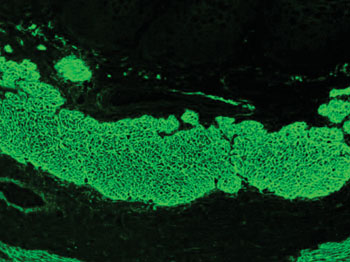Serum Assay Evaluated for Celiac Disease Screening
By LabMedica International staff writers
Posted on 08 Jun 2015
Celiac Disease (CD) is an autoimmune enteropathy triggered by the ingestion of gluten-containing grains in genetically susceptible individuals and it damages the small intestine mucosa leading to villous atrophy, crypt hyperplasia and intraepithelial lymphocytic infiltrate.Posted on 08 Jun 2015
Small bowel biopsy is the conventional gold standard for the diagnosis of CD, but greater emphasis is now given to serological assays like anti-tissue Transglutaminase immunoglobulin (Ig) A antibodies (anti-tTGA), anti-Deamidated Gliadin Peptides IgA and IgG antibodies (a-DGP IgA/IgG) and anti-Endomysium IgA antibodies (EMA).

Image: Immunofluorescence pattern of endomysial antibodies produced using serum from a patient with celiac disease on monkey esophagus with a fluorescein isothiocyanate (FITC) conjugate (Photo courtesy of Simon Caulton).
Scientists at the University of Naples Federico II (Italy) selected 730 children aged between six months and four years nominated Group A: 652 non-CD and 78 CD, and 348 children younger than two years nominated Group B: 327 non-CD and 21 CD which were part of Group A. These groups were used to evaluate the agreement between anti-tTGA and a-DGP IgA/IgG by Kappa coefficient and to compare the diagnostic accuracy of anti-tTGA with that of a-DGP IgA/IgG by Receiver Operating Characteristic (ROC) curve analysis.
Sera from the groups were assayed for IgA and IgG antibodies a-DGP and IgA antibodies anti-tTG by enzyme-linked immunosorbent assay (ELISA) test (Delta Biologicals; Rome, Italy). The IgA antibodies anti-Endomysium were detected by Delta Biological’s Indirect Immunofluorescence (IFI) assay using sections of distal monkey esophagus mounted on glass slides at a starting dilution of 1:5, which was considered the threshold for positivity.
There was a substantial agreement between anti-tTGA and a-DGP IgA in Group A and an almost perfect agreement in Group B. The strength of agreement between anti-tTGA and a-DGP IgG was moderate in Group A and substantial in Group B. The anti-tTGA was more sensitive and specific than a-DGP IgA/IgG in both groups. The strongest point of the current study was the cutoff values being adjusted for the study population in case of all antibody assays according to Receiver Operator Characteristic (ROC) curve analysis.
The authors concluded that anti-tTGA, because of their high diagnostic accuracy, may be used as initial screening assay for CD in all subjects from six months of age, according to new European Society of Pediatric Gastroenterology Hepatology and Nutrition (ESPGHAN) Criteria 2012. The study was published on June 15, 2015, in the journal Clinica Chimica Acta.
Related Links:
University of Naples Federico II
Delta Biologicals














